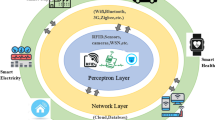Abstract
With the proliferation of various wireless services such as Third Generation, Fourth Generation, Wireless Local Area Network, and Personal Area Network, etc., users request for access to the Next Generation Internet in more heterogeneous networks. The network mobility working group within the Internet Engineering Task Force introduced the Network Mobility (NEMO) concept as a network mobility basic support protocol (i.e., network moves as a unit) extended from Mobile IPv6 (MIPv6). However, this solution has the limitation of route optimization that should be always passed by Home Agents (HAs) using a bi-directional tunnel with its Mobile Router (MR). It is not also entirely supported a security requirements and various attacks (e.g., Denial of Service attack, redirect attack, etc.). Most of all, it is not mentioned how authentication issues between a HA and a Correspondent Node (CN) are solved in NEMO environments. To ameliorate these problems, we propose novel authenticated route optimization scheme to be performed by MR and CN of Mobile Network Nodes, which uses IDentity-based cryptosystem (that is, a Multi-Private Key Generator Based Authenticated Key Agreement between MRs) to look upon heterogeneous NEMO environments. In performance analysis, we analytically compute the protocol’s connectivity recovery and end-to-end delay time and then compare the security and the efficiency of proposed scheme with the NEMO Basic support protocol, i.e., RFC 3963.





Similar content being viewed by others
References
Johnshon, D., Perkins, C., & Arkko, J. (2005). Mobility support in IPv6.In Internet Engineering Task Force (IETF), RFC 3775.
Devaraalli, B. V., Wakikawa, R., Petrescu, A., & Thuber, P. (2006). Network mobility basic support protocol. In IETF, RFC 3963.
Ng, C., Thubert, P., Watari, M., & Zhao, F. (2008). Network mobility route optimization problem statement. In Internet draft, draft-ietf-nemo-ro-problem-statement-03.txt (work in progress).
Aura, T. (2005, March). Cryptographically Generated Addresses (CGA). In IETF, RFC 3972.
Fathi, H., Shin, S., Kobara, K., Chakraborty, S. S., Imai, H., & Prasad, R. (2008). LR-AKE-based AAA for network mobility (NEMO) over wireless links. IEEE Journal on Selected Areas in Communications, 24(9), 1545–1557.
Koo, J. D., & Lee, D. Ch. (2007). Extended ticket-based binding update (ETBU) protocol for mobile IPv6 (MIPv6) networks. IEICE Transactions on Communications, 90(4), 777–787.
Kim, S., Lee, H., & Oh, H. (2006). Enhanced ID-based authenticated key agreement protocols for a multiple independent PKG environment. In ICICS 2006. Lecture Notes on Computer Science (Vol. 3783, pp.145–152).
Boneh, D., & Franklin, M. (2001). Identity-based encryption from the Weil Pairing. In Advanced in cryptology, Crypto 2001, Lecture Notes on Computer Science (Vol. 2139, pp. 213–229).
Arkko, J., Devarapalli, V., & Dupont, F. (2005). Using IPsec to Protect Mobile IPv6 signaling between mobile nodes and home agents. In IETF RFC 3776.
Ernst, T., & Lach, H.-Y. (2008, November). Network mobility support terminology. In Internet draft, draft-ietf-nemo-terminology-06.txt (work in progress).
Ng, C., Zhao, F., Watari, M., & Thubert, P. (2008). Network mobility route optimization solution space analysis. In Internet draft, draft-ietf-nemo-ro-space-analysis-03.txt (work in progress).
Calderon, M., Bernados, C. J., Bagnulo, M., & Soto, I. (2005). Securing route optimization in NEMO. In Third international symposium on modeling and optimization in mobile, ad hoc, and wireless networks (WiOpt’05) (pp. 248–254).
McCullagh, N., & Barreto, P. S. L. M. (2005). A new two-party identity-based authenticated key agreement. In Proceedings of CTRSA 2005, Lecture Notes on Computer Science (Vol. 3376, pp. 262–274).
Bellare, M., & Rogaway, P. (1994). Entity authentication and key distribution. In Advance in cryptology—Crypto’93, Lecture Notes on Computer Science (Vol. 773, pp. 232–249).
Huang, C. M., Lee, C. H., & Zheng, J. R. (2006). A novel SIP-based route optimization for network mobility. IEEE Journal on Selected Areas in Communications, 24(9), 1682–1691.
Ahn, Y., Lee, T., & Choo, H. (2009). Lightweight bindings for mobile routers. In ICCSA 2009, Lecture Notes on Computer Science (Vol. 3981, pp. 661–670).
Kleinrock, L. (1975). Queuing system: Theory, Vol I. New York: Wiley.
Author information
Authors and Affiliations
Corresponding author
Rights and permissions
About this article
Cite this article
Kim, K.J., Lee, D.C. Secure Route Optimization Scheme for Network Mobility Support in Heterogeneous Mobile Networks. Wireless Pers Commun 94, 331–349 (2017). https://doi.org/10.1007/s11277-015-3019-5
Published:
Issue Date:
DOI: https://doi.org/10.1007/s11277-015-3019-5




